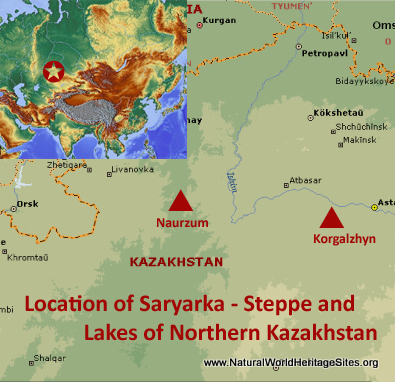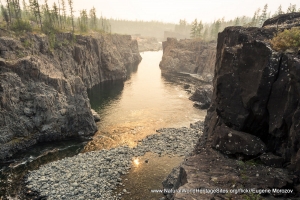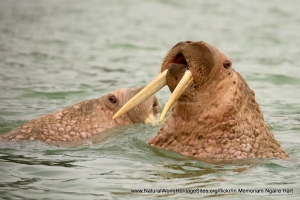EXPLORE the Saryarka: Steppe and Lakes of Northern Kazakhstan with this slideshow, check the location map and get all the facts and information below.
For slideshow description see right or scroll down (mobile). Click to view slideshow
Location and Values: Saryarka: Steppe and Lakes of Northern Kazakhstan is a serial site with four component reserves in two clusters, contained within the Naurzum and Korgalzhyn State Nature Reserves. They lie within a wide belt of temperate grasslands (Eurasian steppe) that occurs at this latitude between the boreal pine forests to the north and dry semi-desert environments to the south. The reserves protect a series of lakes and wetlands of international importance for migratory waterbirds, at a crossroads between two major migratory flyways (one of which passes between northern Scandinavia and the far east, the other between the Siberian Arctic and areas in the southern hemisphere). The wetlands are key stopover points and feeding grounds for 15-16 million birds, while some 500,000 birds of 120 species also breed in the reserves. The lakes are shallow and subject to severe flood/drought cycles, which creates conditions of fluctuating water levels and varying salinity (producing a white crust of sodium and sulfate salts in places). The wetlands support a number of globally threatened birds including the Siberian white crane, Damatian pelican and Pallas’s fish eagle.
In addition to the freshwater and saline lakes (with their associated aquatic and halophytic habitats), there are significant areas of northern forest, steppe and semi-desert environments. These environments provide habitat for the critically endangered Mongolian saiga antelope and several locally endemic small mammals.
Conservation Status and Prospects. According to IUCN’s Conservation Outlook Assessment (2020) the conservation status of Saryarka: Steppe and Lakes of Northern Kazakhstan is ‘good, with some concerns’. The IUCN report notes a number of positive recent developments, including (1) extension of the Korgalzhyn State Nature Reserve to include nearby areas of steppe and forest habitats, (2) an increase in the global population of white-headed duck, (3) rapid recovery of the saiga antelope population following a mass die-off in 2015 and (4) continued effective management including important recent interventions to address decreasing water levels in freshwater lakes and water pollution. However, despite these positive trends, there remains some concern over (1) insufficient funding for management, (2) uncontrolled hunting, (3) the potential impact of climate change, (4) the incidence of fires and (5) agricultural development and loss of habitat in areas around the site, especially to the west.
Links:
Google Earth
Official UNESCO Site Details
IUCN Conservation Outlook
UNEP-WCMC Site Description
Birdlife IBA
Slideshow description
The slideshow ‘tells the story’ of Saryarka: Steppe and Lakes of Northern Kazakhstan with a portfolio of photos that illustrate the landscape features and wildlife of the site. The slideshow begins with some images of the Korgalzhyn reserve, including an aerial view of its extensive swamplands followed by a satellite image of the lake complex here. The extensive steppe environments along the roadside on the approach to the lakes are shown, together with some of the typical larger birds – spoonbills, Dalmatian pelican, demoiselle cranes and a vast flock of geese. Aquatic margins have extensive areas of common Phragmites reed, and large numbers of waterfowl can be seen on the water, including wigeon, pochard, coot, mallard and white-headed duck, while greater flamingos move between the more brackish/saline waters. Pallas gulls congregate on meadows at the water’s margins while ruddy shelduck and Siberian white crane are shown in flight. The slideshow ends with a couple of photos from Naurzum State Nature Reserve, which includes a more diverse range of grassland and forest habitats and supports a population of the critically endangered Mongolian saiga antelope.
The following Flickr photographers and other sources are acknowledged with thanks for their contributions to this slideshow: Sue-Cro, Darren-Birgenheier, Hari-K-Patibanda, Alex-Curylo, Darwin-Initiative, Axelle-Piot, capepolly, GEF, Jose-Lama, Diresh-Duggiralla, Simon-Thompson, UNDP, Sergey-Yeliseev, Terr-bo, Williston-Library, Alder-Chang, Tony-Sutton, cuatrok77, Jeremy-Halls and Mark-Hope.
Factfile
Website Categories:
Lakes, Freshwater Wetlands & Glaciers;
Temperate Grasslands, Steppes, Shrub-Lands & Tundra
Area: 4,503 km2
Inscribed: 2008
UNESCO Criteria:
- Ecological processes (ix);
- Natural habitat for biodiversity (x);
- Significant number of rare, endemic and/or endangered species (x)




